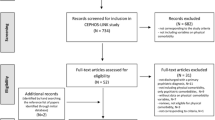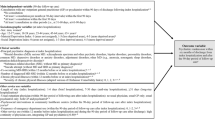Abstract
Purpose
Psychiatric readmission is a common negative outcome. Predictors of readmission may differ by sex. This study aimed to derive and internally validate sex-specific models to predict 30-day psychiatric readmission.
Methods
We used population-level health administrative data to identify predictors of 30-day psychiatric readmission among women (n = 33,353) and men (n = 32,436) discharged from all psychiatric units in Ontario, Canada (2008–2011). Predictor variables included sociodemographics, health service utilization, and clinical characteristics. Using derivation data sets, multivariable logistic regression models were fit to determine optimal predictive models for each sex separately. Results were presented as adjusted odds ratios (aORs) and 95% confidence intervals (CI). The multivariable models were then applied in the internal validation data sets.
Results
The 30-day readmission rates were 9.3% (women) and 9.1% (men). Many predictors were consistent between women and men. For women only, personality disorder (aOR 1.21, 95% CI 1.03–1.42) and positive symptom score (aOR 1.41, 95% CI 1.09–1.82 for score of 1 vs. 0; aOR 1.44, 95% CI 1.26–1.64 for ≥ 2 vs. 0) increased odds of readmission. For men only, self-care problems at admission (aOR 1.20, 95% CI 1.06–1.36) and discharge (aOR 1.44, 95% CI 1.26–1.64 for score of 1 vs. 0; aOR 1.79, 95% CI 1.17–2.74 for 2 vs. 0), and mild anxiety rating (score of 1 vs. 0: aOR 1.30, 95% CI 1.02–1.64, derivation model only) increased odds of readmission. Models had moderate discriminative ability in derivation and internal validation samples for both sexes (c-statistics 0.64–0.65).
Conclusions
Certain key predictors of psychiatric readmission differ by sex. This knowledge may help to reduce psychiatric hospital readmission rates by focusing interventions.


Similar content being viewed by others
References
OECD (2013) "Unplanned hospital re-admissions for patients with mental disorders" in Health at a Glance 2013: OECD indicators, OECD Publishing, Paris
Canadian Institute for Health Information (2011) Health indicators 2011. Canadian Institute for Health Information, Ottawa
Heslin KC, Weiss AJ (2015) Hospital readmissions involving psychiatric disorders, 2012. HCUP Statistical Brief #189
Rieke K, McGeary C, Schmid KK, Watanabe-Galloway S (2016) Risk factors for inpatient psychiatric readmission: are there gender differences? Commun Ment Health J 52:675–682. doi:10.1007/s10597-015-9921-1
Tulloch AD, David AS, Thornicroft G (2016) Exploring the predictors of early readmission to psychiatric hospital. Epidemiol Psychiatr Sci 25:181–193. doi:10.1017/s2045796015000128
Vigod SN, Kurdyak PA, Seitz D, Herrmann N, Fung K, Lin E, Perlman C, Taylor VH, Rochon PA, Gruneir A (2015) READMIT: a clinical risk index to predict 30-day readmission after discharge from acute psychiatric units. J Psychiatr Res 61:205–213. doi:10.1016/j.jpsychires.2014.12.003
Vigod SN, Kurdyak PA, Dennis CL, Leszcz T, Taylor VH, Blumberger DM, Seitz DP (2013) Transitional interventions to reduce early psychiatric readmissions in adults: systematic review. Br J Psychiatry 202:187–194. doi:10.1192/bjp.bp.112.115030
Vigod SN, Kurdyak P, Fung K, Gruneir A, Herrmann N, Hussain-Shamsy N, Isen M, Lin E, Rochon P, Taylor VH, Seitz D (2016) Psychiatric hospitalizations: a comparison by gender, sociodemographics, clinical profile, and postdischarge outcomes. Psychiatr Serv 67:1376–1379. doi:10.1176/appi.ps.201500547
Benda BB (2004) Life-course theory of readmission of substance abusers among homeless veterans. Psychiatr Serv 55:1308–1310. doi:10.1176/appi.ps.55.11.1308
Ono T, Tamai A, Takeuchi D, Tamai Y (2011) Factors related to readmission to a ward for dementia patients: Sex differences. Psychiatry Clin Neurosci 65:490–498. doi:10.1111/j.1440-1819.2011.02251.x
Brennan PL, Kagay CR, Geppert JJ, Moos RH (2000) Elderly Medicare inpatients with substance use disorders: characteristics and predictors of hospital readmissions over a four-year interval. J Stud Alcohol 61:891–895
D’Ercole A, Struening E, Curtis JL, Millman EJ, Morris A (1997) Effects of diagnosis, demographic characteristics, and case management on rehospitalization. Psychiatr Serv 48:682–688. doi:10.1176/ps.48.5.682
Wizemann TM (2012) Sex-specific reporting of scientific research: a workshop summary. Institute of Medicine of the National Academies, Washington, DC
Clayton JA, Tannenbaum C (2016) Reporting sex, gender, or both in clinical research? JAMA 316:1863–1864. doi:10.1001/jama.2016.16405
Morgan R, George A, Ssali S, Hawkins K, Molyneux S, Theobald S (2016) How to do (or not to do)… gender analysis in health systems research. Health Policy Plan 31:1069–1078. doi:10.1093/heapol/czw037
Hirdes JP, Marhaba M, Smith TF, Clyburn L, Mitchell L, Lemick RA, Telegdi NC, Perez E, Prendergast P, Rabinowitz T, Yamauchi K, Resident Assessment Instrument-Mental Health G (2000) Development of the resident assessment instrument–mental health (RAI-MH). Hosp Q 4:44–51
American Psychiatric Association (2000) Diagnostic and statistical manual of mental disorders (4th edn., text rev.). doi:10.1176/appi.books.9780890423349
Urbanoski KA, Mulsant BH, Willett P, Ehtesham S, Rush B (2012) Real-world evaluation of the Resident Assessment Instrument-Mental Health assessment system. Can J Psychiatry 57:687–695
John Hopkins Bloomberg School of Public Health (2009) The Johns Hopkins ACG System Technical Reference Guide, Version 9.0. The John Hopkins University, Baltimore
Quan H, Sundararajan V, Halfon P, Fong A, Burnand B, Luthi JC, Saunders LD, Beck CA, Feasby TE, Ghali WA (2005) Coding algorithms for defining comorbidities in ICD-9-CM and ICD-10 administrative data. Med Care 43:1130–1139
Steele LS, Glazier RH, Lin E, Evans M (2004) Using administrative data to measure ambulatory mental health service provision in primary care. Med Care 42:960–965
Hirdes JP, Smith TF, Rabinowitz T, Yamauchi K, Perez E, Telegdi NC, Prendergast P, Morris JN, Ikegami N, Phillips CD, Fries BE (2002) The Resident Assessment Instrument-Mental Health (RAI-MH): inter-rater reliability and convergent validity. J Behav Heal Serv Res 29:419–432
Cohen J (1988) Statistical power analysis for the behavioral sciences, 2nd edn. L. Erlbaum Associates, Hillside
Austin PC (2009) Using the standardized difference to compare the prevalence of a binary variable between two groups in observational research. Commun Stat Simul Comput 38:1228–1234. doi:10.1080/03610910902859574
Allison P (2013) Why I don’t trust the Hosmer-Lemeshow test for logistics regression. Stat Horizons. https://statisticalhorizons.com/hosmer-lemeshow
Callaly T, Trauer T, Hyland M, Coombs T, Berk M (2011) An examination of risk factors for readmission to acute adult mental health services within 28 days of discharge in the Australian setting. Australas Psychiatry 19:221–225. doi:10.3109/10398562.2011.561845
Donisi V, Tedeschi F, Percudani M, Fiorillo A, Confalonieri L, De Rosa C, Salazzari D, Tansella M, Thornicroft G, Amaddeo F (2013) Prediction of community mental health service utilization by individual and ecological level socio-economic factors. Psychiatry Res 209:691–698. doi:10.1016/j.psychres.2013.02.031
Donisi V, Tedeschi F, Wahlbeck K, Haaramo P, Amaddeo F (2016) Pre-discharge factors predicting readmissions of psychiatric patients: a systematic review of the literature. BMC Psychiatry 16:449. doi:10.1186/s12888-016-1114-0
Pedersen L, Simonsen E (2014) Incidence and prevalence rates of personality disorders in Denmark—a register study. Nord J Psychiatry 68:543–548. doi:10.3109/08039488.2014.884630
Nawka A, Kalisova L, Raboch J, Giacco D, Cihal L, Onchev G, Karastergiou A, Solomon Z, Fiorillo A, Del Vecchio V, Dembinskas A, Kiejna A, Nawka P, Torres-Gonzales F, Priebe S, Kjellin L, Kallert TW (2013) Gender differences in coerced patients with schizophrenia. BMC Psychiatry 13:257. doi:10.1186/1471-244x-13-257
Eranti SV, MacCabe JH, Bundy H, Murray RM (2013) Gender difference in age at onset of schizophrenia: a meta-analysis. Psychol Med 43:155–167. doi:10.1017/s003329171200089x
Vigod SN, Taylor VH, Fung K, Kurdyak PA (2013) Within-hospital readmission: an indicator of readmission after discharge from psychiatric hospitalization. Can J Psychiatry 58:476–481
Kansagara D, Englander H, Salanitro A, Kagen D, Theobald C, Freeman M, Kripalani S (2011) Risk prediction models for hospital readmission. JAMA 306:1688. doi:10.1001/jama.2011.1515
Conron KJ, Scott G, Stowell GS, Landers SJ (2012) Transgender health in Massachusetts: results from a household probability sample of adults. Am J Public Health 102:118–122. doi:10.2105/ajph.2011.300315
Berwick DM, Nolan TW, Whittington J (2008) The triple aim: care, health, and cost. Health Aff 27:759–769. doi:10.1377/hlthaff.27.3.759
Sadowski LS, Kee RA, VanderWeele TJ, Buchanan D (2009) Effect of a housing and case management program on emergency department visits and hospitalizations among chronically ill homeless adults: a randomized trial. JAMA 301:1771–1778. doi:10.1001/jama.2009.561
Acknowledgements
This study was supported by a grant from the AFP Innovation Fund of the Ontario Ministry of Health and Long Term Care. It was also supported by the Institute for Clinical Evaluative Sciences (ICES), which is funded by an annual grant from the Ontario Ministry of Health and Long-Term Care (MOHLTC). The opinions, results, and conclusions reported in this paper are those of the authors and are independent from the funding sources. No endorsement by ICES or the Ontario MOHLTC is intended or should be inferred. Parts of this material are based on data and information compiled and provided by the Canadian Institute for Health Information (CIHI). However, the analyses, conclusions, opinions, and statements expressed herein are those of the author, and not necessarily those of CIHI.
Author information
Authors and Affiliations
Corresponding author
Ethics declarations
Conflict of interest
The authors declare that they have no competing interest
Ethical standards
The authors assert that all procedures contributing to this work comply with the ethical standards of the relevant national and institutional committees on human experimentation and with the Helsinki Declaration of 1975, as revised in 2008. This study was approved by the institutional review board at Sunnybrook Health Sciences Centre, Toronto, Canada (ICES logged study: 2013 0904 301 000).
Availability of data and materials
Under Ontario privacy legislation, ICES is a Prescribed Entity under Sect. 45(1) of Ontario’s Personal Health Information Protection Act, 2004 (PHIPA) that is permitted to hold and use administrative, population health, clinical and other data files for the purposes of analysis, evaluation, and decision support. ICES is responsible for ensuring that necessary infrastructure (i.e., privacy office, data linkage and security measures, and data sharing agreements) is in place to comply with these policies and to maintain the data platform. Due to these privacy regulations, we are not permitted to share participant-level data.
Electronic supplementary material
Below is the link to the electronic supplementary material.
Rights and permissions
About this article
Cite this article
Barker, L.C., Gruneir, A., Fung, K. et al. Predicting psychiatric readmission: sex-specific models to predict 30-day readmission following acute psychiatric hospitalization. Soc Psychiatry Psychiatr Epidemiol 53, 139–149 (2018). https://doi.org/10.1007/s00127-017-1450-5
Received:
Accepted:
Published:
Issue Date:
DOI: https://doi.org/10.1007/s00127-017-1450-5




